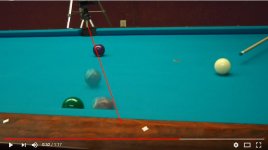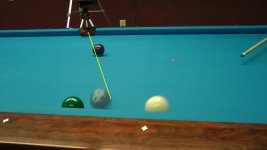Your lines now look good and are on the edges of the ball instead of significantly off in space.
As Dr. Dave pointed out in post #18, there are still a couple of optical illusions happening here because the ball is airborne, and because we are off to the left of the line of the shot instead looking directly down the line of the shot.
I think I can add to what Dr. Dave said in post #18 to help you visualize what he is talking about. First, imagine that your photo in post #17 is not a photo at all, but is what you are seeing in person because your eyeballs are in exactly the same spot as the camera was. Now also imagine that all the motion was frozen in time exactly as you see in your picture, and the seven ball is levitating motionless in mid air just as you see in the picture as you are looking at the table. To visualize what Dr. Dave is talking when he says that the seven being airborne creates an illusion, imagine that without moving your head you reach out and push the levitating seven ball straight back down onto the table. It would no longer be touching your yellow line. If for some reason you are still not able to visualize that, then imagine the opposite. Imagine that without moving your head that you reach out and raise the seven ball straight up a full ball width higher that it is now. You will see that the yellow "string" would then be very significantly over the seven ball, probably about cutting it in half, yet we didn't do anything but raise the seven ball straight up and down. If you move the seven ball up, it will appear to move closer to the line, and if you move it down it will appear to move further from the line. In this case the seven is airborne so it looks like it is touching the yellow line when it really isn't and if you were to "push the seven ball down" you would see that the line is not actually on the edge of the ball.
To visualize what Dr. Dave is talking about when he says that being filmed from the left creates also creates an optical illusion, again imagine this is you in person looking at all the balls frozen in space, with the seven ball levitating in space just as it appears in the photo, and then also imagine that your yellow line is actually a yellow piece of yarn that is also levitating in space. Now imagine moving your head to the right until you are looking directly down the line of the yellow piece of yarn. As you moved your head to the right, the yellow levitating yarn would appear to be moving to the left off of the edge of the four ball, and by the time your head is directly in line with the piece of yellow yarn you will see that the piece of yarn actually isn't above any part of the four ball at all but is actually just off to the side of it. It is just that when you were looking from the left, the same angle as your picture, it just appeared to be over the four ball from that angle when it actually wasn't. Filming from an angle like this creates substantial optical illusions and doesn't allow for much accuracy. For the most precision in the future for this kind of shot you want to try to get your cameras looking exactly down the line of the shot (and exactly down the line of where your yellow line will end up being) and not off to the side even a little bit because even a little bit leads to significant optical illusions and inaccuracy.
Then you also still have what Dr. Dave pointed out in post #13. We simply don't have enough frames to accurately know where the seven was as it came off the rail as the frame or frames that would accurately show this simply don't exist. We do however have what appears to be a frame showing fairly precisely where the seven first hit the table after being airborne from the rebound. Since this is the first place we can accurately determine where the seven ball was, for the most accuracy you should have drawn your line from the edge of the seven ball at the place where it first hit the table on over to the edge of the seven ball as it is just about to drop into the pocket. This isn't perfectly accurate either, but it would be the most accurate based on the video we have to work with because trying to guess precisely where the seven ball left the rail was just that, a guess (we are missing the frames showing it, and the seven immediately going airborne from the rail makes it even harder to precisely guesstimate where it happened) . For the very best accuracy though you have to video that was shot from perfectly in line with the line of the shot and not even slightly from the side, you need a seven that doesn't start going airborne from the rail, and you need the frames that precisely show exactly where the seven was as it leaves the rail which would likely require a higher frame per second camera. All told it appears that you got a little curve with your shot, but probably only about an 1/8th inch or so, possibly 1/4 inch, and it also appears that with where you located the four ball the bank was very possible without any curve being needed at all (although it was fairly tight for sure).

